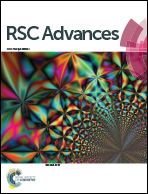PAMPS-graft-Ni3Si2O5(OH)4 multiwalled nanotubes as a novel nano-sorbent for the effective removal of Pb(ii) ions†
Abstract
The existence of Pb(II) ions in water systems poses significant potential hazards to public health and the environment. In the present study, poly(2-acrylamido-2-methylpropanesulfonic acid) (PAMPS) brush-modified Ni3Si2O5(OH)4 nanotubes were prepared, and their adsorption efficiency against the Pb(II) ions was investigated. The characterization results of FTIR spectroscopy, TGA, TEM, and XPS indicated the successful grafting of PAMPS on the surface of free Ni3Si2O5(OH)4 NTs, and the prepared PAMPS-g-Ni3Si2O5(OH)4 NTs exhibited a 6–8 nm grafting layer, which could provide abundant binding sites for metal adsorption. During the Pb(II) removal process, a pH-dependent adsorption behavior was observed, and the adsorption processes fitted well with the pseudo-second-order kinetic model and the Langmuir isotherm model. Compared with unmodified Ni3Si2O5(OH)4, the PAMPS-g-Ni3Si2O5(OH)4 NTs exhibited obviously faster adsorption of Pb(II) and higher equilibrium adsorption capacity for the removal of Pb(II). The maximum adsorption capacity calculated via the Langmuir isotherm model was 0.653 mmol g−1 (135.3 mg g−1) at 298 K. In a metal coexisting system, the total adsorption capacity of the NTs was increased; this indicated the potential of the proposed NTs in the removal of Pb(II) from metal coexisting wastewater. This study showed the significant potential of PAMPS-g-Ni3Si2O5(OH)4 NTs in the effective removal of Pb(II).



 Please wait while we load your content...
Please wait while we load your content...